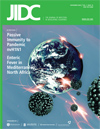Ventilator-associated pneumonia in a tertiary care hospital in India: incidence and risk factors
DOI:
https://doi.org/10.3855/jidc.396Keywords:
Ventilator-Associated Pneumonia, risk factors, Emergency intubation, tracheostomyAbstract
Background: Knowledge of the incidence of ventilator-associated pneumonia (VAP) and its associated risk factors is imperative for the development and use of more effective preventive measures.
Methodology: We performed a prospective study over a period of 15 months to determine the incidence and the risk factors for development of VAP in critically ill adult patients admitted in different intensive care units (ICUs) of Jawaharlal Institute of Post-graduate Medical Education and Research (JIPMER), a tertiary care hospital in Pondicherry, India.
Results: The incidence of VAP was 30.67 and 15.87 per 1,000 ventilator days in the two different ICUs. In our study 58.3% of the cases were late-onset VAP, while 41.7% were early-onset VAP. Univariate analysis indicated that the following were significantly associated with VAP: impaired consciousness, tracheostomy, re-intubation, emergency intubation, and nasogastric tube. Emergency intubation and intravenous sedatives were found to be the specific risk factors for early onset VAP, while tracheostomy and re-intubation were the independent predictors of late-onset VAP by multivariate logistic regression analysis.
Conclusions: Knowledge of these risk factors may be useful in implementing simple and effective preventive measures including non-invasive ventilation, precaution during emergency intubation, minimizing the occurrence of reintubation, avoidance of tracheostomy as far as possible, and minimization of sedation.
Downloads
Published
How to Cite
Issue
Section
License
Authors who publish with this journal agree to the following terms:
- Authors retain copyright and grant the journal right of first publication with the work simultaneously licensed under a Creative Commons Attribution License that allows others to share the work with an acknowledgement of the work's authorship and initial publication in this journal.
- Authors are able to enter into separate, additional contractual arrangements for the non-exclusive distribution of the journal's published version of the work (e.g., post it to an institutional repository or publish it in a book), with an acknowledgement of its initial publication in this journal.
- Authors are permitted and encouraged to post their work online (e.g., in institutional repositories or on their website) prior to and during the submission process, as it can lead to productive exchanges, as well as earlier and greater citation of published work (See The Effect of Open Access).








